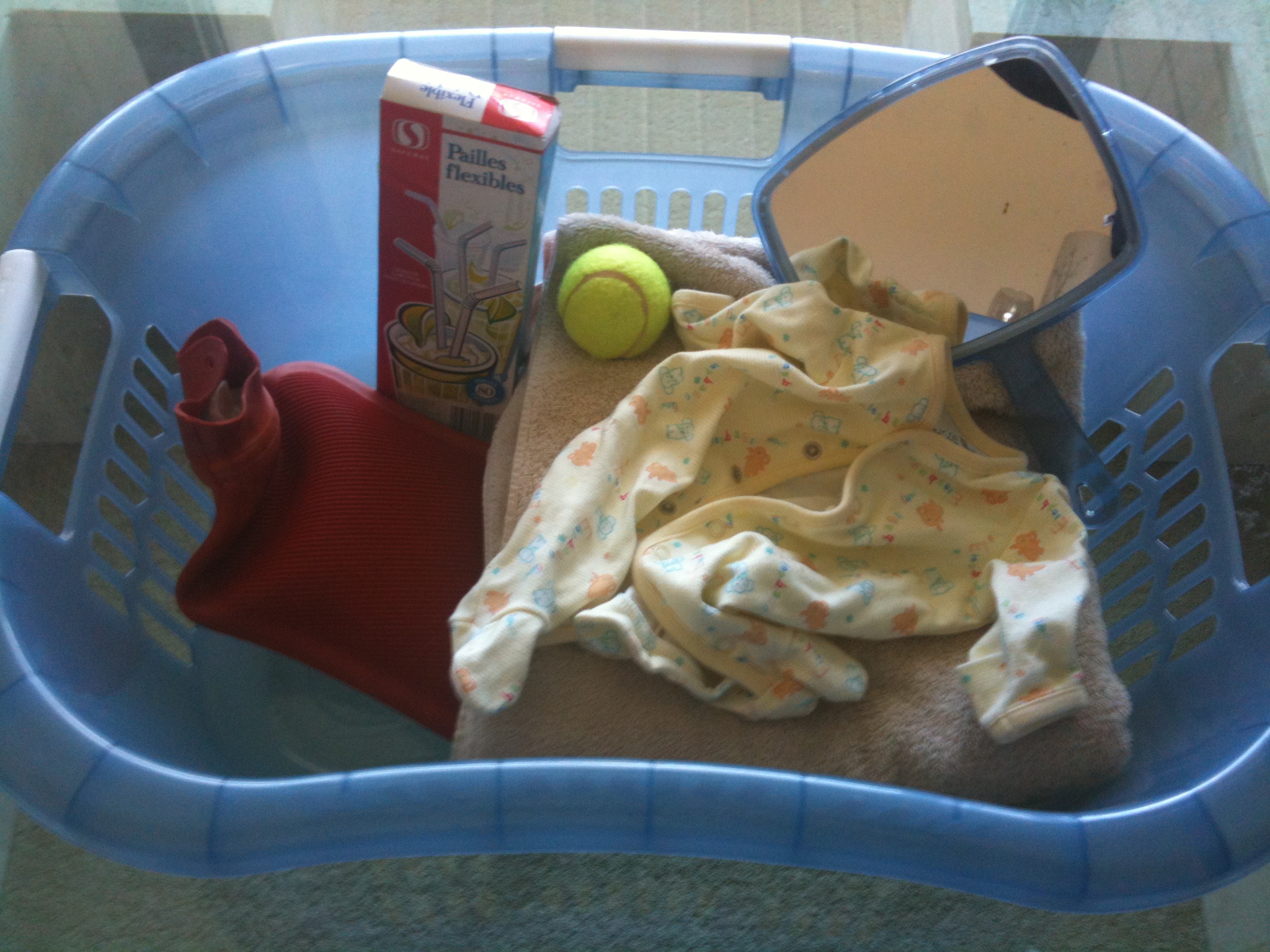 First thing to remember is that they are many factors at play in this situation. So I think that it’s important to realize that no one technique will be the ticket! My best advice is to do all of the suggestions for preventing and/or limiting tearing. The more angles that you come at this from, the more likely you will birth your baby with an intact perineum.
First thing to remember is that they are many factors at play in this situation. So I think that it’s important to realize that no one technique will be the ticket! My best advice is to do all of the suggestions for preventing and/or limiting tearing. The more angles that you come at this from, the more likely you will birth your baby with an intact perineum.
Ok. Starting the list of techniques…
1. Good Fats Eat healthy food rich in good oils and fats. The reason for this is that the skin absorbs what you take in through your digestive system. So if you are eating good fats then your skin will have more moisture and elasticity. Foods rich in vitamin E are great for this; like wheat germ (add to baking, cereal, smoothies etc) and avocado. Local midwife, Lana Knoll, did her final research paper on this topic and concluded that the top factor for tearing or not tearing was the health of the tissues. Eat a very healthy diet rich in the good-for-you fats and you will have healthy tissues.
2. Perineal Massage The massage increases both the overall health and elasticity of the perineum. Healthy tissue = better chances! The trouble is that although people talk about perineal massage, no one actually explains how to do it. As result people don’t do it. But truly it’s very easy. This is to be done six – eight weeks prior to birth – starting about the 32 to 34 weeks mark. And it is to be done EVERYDAY for five minutes.
Ok so here’s how to do it.
Pour a little oil (must be natural fragrance free oil – I suggest Coconut or Olive Oil – both are cheap, accessible and hypo-allergenic!) into a shallow bowl.
Sit with your back resting against pillows and get comfortable. It’s a good idea to use a mirror during the first few times that you do this exercise. It will assist you in identifying the muscles involved and allow you to observe the easing of the edge of the perineum.
Dip your thumb into the oil (finger nails smooth and short and hand very clean) and thoroughly moisten it. If a partner is doing the massage, he will use his first and middle fingers. The thumb and fingers should be dipped into the oil to the second knuckle and inserted into the vagina approximately two to three inches, pressing downward on the area between the vagina and the rectum. Rub the oil into the inner edge of the perineum and the lower vaginal wall.
Maintaining a steady pressure, slide the fingers upward along the sides of the vagina in the U sling type motion. This pressure will stretch the vaginal tissue, the muscles surrounding the vagina and the outer rim of the perineum. Be sure to stretch the inner portions as well as the outer rim of the perineum. In the beginning you will feel the tightness of the muscles, but with time and practice, the tissue will relax.
If you are doing the massage by yourself, you’ll find it easier if you place one foot on the seat of a chair, with the other approximately two or three feet away from the chair. This allows you to work around and under your abdomen from the back.
3. Kegel or Pelvic Floor Exercises Again everyone talks about them but no one really explains them in depth. I actually attended a weekend workshop all about the pelvic floor – so there is a lot to discuss!
Ok… so there are actually two layers of muscles that we are talking about here. There are the deeper internal muscles that line the walls of the vagina (remember the vagina is more than the labia or lips – the vagina actually refers to the muscles walls going in and up to the uterus.) So you pull up with these muscles.
The second layer of muscles are the surface muscles – these run like a figure eight around the vagina (including the urethra) and around the anus. The cross of the figure eight occurs between the vagina and the anus, known as the perineum. This muscle layer pulls together during a Kegel. It helps to imagine the four points of the pelvis – the tail bone, pubis, the sitz bones (the bony bits in your bum when you sit down). These four points mark your pelvic outlet and if you imagine pulling them all closer together than you will have the correct muscle action in this area.
A full Kegel involves pulling up and then pulling in or engaging the inner muscles and then the surface muscles of the pelvic floor.
There are variations you can do with this… short pulls, long holds, the elevator – my personal favourite – ground floor is completely relaxed, second floor a bit engaged, third floor – mostly engaged and fourth floor completely engaged – and then you bounce between floors!
All of this helps to strengthen the mind-body connection between your awareness (mind) and this particular spot (body). That is another reason it is worthwhile… it’s subtle at first but the more you do it, the more you will feel like you know and understand this area.
As an aside, even women who are having a planned C-section need to do this exercise because the weight of the pregnancy weakens the pelvic floor.
Now if you are totally unsure if you are doing it right, try this.
These muscles are the same ones used to stop the flow of urine. So next time you are in the bathroom, attempt to stop the flow while you are urinating… however do NOT practice in this way as it can lead to bladder infections!
Also I need to add that a muscle that is healthy stretches better – that’s why it works to do Kegels (which are tightening exercises) in order for the perineum to stretch more easily.
4. Optimal Fetal Positioning Baby’s position also plays a factor.The optimal position for birth is baby with head down, chin tucked in, spine facing out against your belly and their arms tucked down by their body. In this position, it’s easiest for the bones of baby’s head to mould making it easier for them to move through your pelvis. And if baby’s arms and hands are down this also greatly impacts the integrity of the perineum. So how can you increase the chances that baby is this optimal position? Spend time on all fours, doing cat stretch for instance, helps because gravity then works to move baby’s spine forward (facing outwards against your belly which is optimal). I love the website www.spinningbabies.com for its discussion and ideas about optimal positioning. Visualization is another powerful tool. Envision baby is the prefect position in the days leading up to labour. This image will help you visualize baby in that optimal position. And talk you your baby about being in this position – “sweetie when it’s time to be born, be head down, with your spine against my belly, your chin tucked in, and your arms down at your sides.” Over the past decade of working with birth, visualization practice during pregnancy, has been one of the most powerful tools I’ve encountered as a way to prepare the mind and body for labour.
5. Support The Perineum During Birth Have someone; nurse, doctor, doula, or your partner, support the perineum when baby’s head is crowning. You can do this with using a hand, or a warm face cloth or warm oil compress. A study in Norway, published in 2008 found that when a women’s perineum was manually supported and the woman breathed deep and slowed down (no pushing) as the head came through, then the incidents of tearing were dramatically decreased. And you might not have considered this – but YOU can support your own perineum. That’s right – it’s actually your body and you are allowed to touch it! So if you feel the urge to place your hands “down there” when the vulva are opening and bulging – do it. Follow that instinct. While you are pregnant, this is a great time to talk to your care provider and see if they are willing to gently manually support the perineum during birth.
6. Use Helichrysum Use helichrysum essential oil on the perineum during crowning. This is a deeply healing oil and it has a powerful ability to stop bleeding and prevent tears. Mixed with fractionated coconut oil, at a rate of 3 drops to 2 tablespoons, Helichrysum is a wonderful for perineum support. Gently gently massage it on the perineum during crowning and also rub gently over baby’s head. For moms, it will help the prevent tears and for babies, it will help prevent bruising and swelling. Learn more about essential oils for birth.
7. Keep Mouth, Jaw and Lips Soft As the famous midwife Ina May Gaskin always says: “whatever your lips up here are doing, that’s what your lips down there are doing”. This is called the sphincter law. For some reason, the muscles of the mouth and jaw and linked to the vaginal opening muscles. So if you are bearing down with a really tight mouth and jaw (which many women do if they hold their breath) then that tightens up your bottom. You can actually do this right now. Lock your jaw, bite down, tighten your lips and push down like when you are having a bowel movement; you’ll notice that your bottom tightens up as well. Next exhale with soft lips, space between your back teeth and a loose jaw; notice how soft your pelvic floor is when you exhale in this way.
8. Your Position The last important factor is your own position at birth combined with how forcefully baby is “expelled” or slips out of your body. Some positions seem to be better. Anything off your back is generally better. And taking the time to breath baby out with several breaths… the baby’s head needs time against the folds of the vagina in order to fully allow them to flower and open. If baby comes too fast, for instance because of very strong pushing, tearing is much more likely. Remember the uterus pushes, which is different than you forcefully pushing. If you breath down and out through your vagina then you can let the uterus do most of the work. However, there are situations which can necessitate forcefully pushing – such a sustained and substantial drop in the baby’s heart rate. But in the absence of such the situation, then the best plan is to slowly breathe baby’s head through your vaginal opening. When your baby is crowning and you are right in the intensity of the moment, feeling like you are going to split apart because it’s such a huge feeling, you might think to yourself “All I need to do is give one almighty push right now and it will be all over – and who cares if I tear, just push like hell and get it done”. IGNORE that thought! Tune into your wisest self and think to yourself “Just go slow, hang in there. It’s ok. Just breathing through and letting my tissues unfold will help me stay together and that means a lot less discomfort in the long run.” Choosing the right care provider (doctor or midwife) can really help here. Someone who says something along the lines of “Okay Sarah, easy…. baby is almost here, easy easy… breathe with me… haaaaahhh haaaaahhhh haaaaahhhh…. good… nice and slow… you are stretching beautifully…” That’s the kind of birth attendant that you want. So have a discussion with your care provider about how they generally manage this part of birth.
And that’s it. I think it’s important to mention that with this, as with everything in birth; it is really crucial to prepare your mind and body with dedication and then to LET GO OF ALL ATTACHMENTS when you are actually in labour. Rather than being focused of your plan, you need to be focused on the moment! Birth can be the ultimate living in the present moment (very much a yoga philosophy). Trust yourself, your body and your baby.
Marie
If you enjoyed this post, you might also like…
Using essential oils during your labour can be a wonderful way to support what your body is doing in a gentle and holistic way. During birth there is truly a lot going on, at every level: physically, emotionally, mentally and even spiritually. The thing I love about essential oils is that they help at all these levels and really give the body, the mind and the spirit tools to help regain balance. Keep Reading
I met with my midwife, Debbie, on Friday, August 24th for my 41 week appointment. I was healthy, baby was doing fine, but after a quick check, she informed me that cervix was nowhere near ready. Debbie told me she would not be working on Saturday but I didn’t need to worry about it because it appeared that I wouldn’t be going in to labour anytime soon. Keep Reading
.







